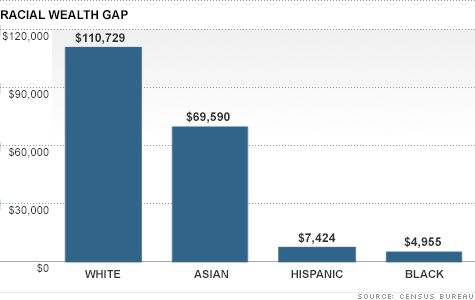For some reason I can't post to your individual blogs on waging a living.
It's understandable that you found the film Depressing. It underscores that employment does not guarantee economic security and for low wage workers often means terrible poverty. And terrible stress. This is not a reality that we often hear about in the media or from conservative discourse which often argues that people are poor because they have failed somehow or lack certain values.
One section of the film that I find,most disturbing is when the woman who is trying to finish college talks to her professor about her problems with the course. He urges her to apply herself!
Jacki posted a brief commentary on the film which was really interesting. Though if I had been that reporter I would have flipped his solutions and started with expanded social and political support
You've posted good links.
Monday, March 25, 2013
Friday, March 15, 2013
Remember our speaker on STRIKE DEBT!
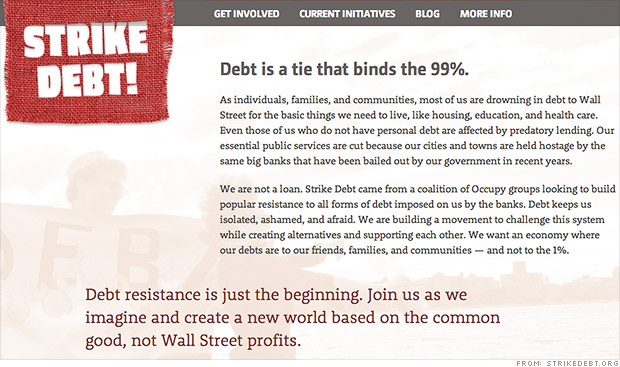 Occupy Wall Street offshoot, Strike Debt, is buying people's emergency room debts for pennies on the dollar and forgiving them.
Occupy Wall Street offshoot, Strike Debt, is buying people's emergency room debts for pennies on the dollar and forgiving them.
When a bank, lender or other company, like a
hospital, is unable to collect on a debt, it typically sells it to debt
buyers or collectors -- often at a much lower price than the original
amount owed since the odds of collecting the money are low. Whoever buys
the debt then attempts to get the money from the debtor.
Related: Debt collection horror stories
Citing the large number of bankruptcies that stem from medical bills, Strike Debt's mission is to stop this collection cycle and abolish the debt altogether.
"Our privatized health care system buries ordinary people in debt all to enrich the 1%," the group said.
The more than $1 million in debt the group eliminated belonged to 1,064 people, amounting to an average of about $900 in debt per person. These randomly-selected people will receive notices explaining that their debt has been forgiven.
The organization spent about $21,000 to purchase the debt, using money raised from supporters.
Related: What business can learn from Occupy Wall Street
To rally the troops around its debt-busting initiative, Occupy's Strike Debt is planning protests later this month against private insurance companies and other events to raise awareness about hospital closings due to excessive amounts of debt.
Strike Debt originally launched its campaign and fundraising efforts in November, abolishing more than $100,000 in consumer debt before the end of 2012.
http://money.cnn.com/2013/03/15/pf/occupy-wall-street-debt/index.html
Occupy offshoot forgives $1 million in random people's debt
By Blake Ellis @CNNMoney March 15, 2013: 3:40 PM ET Occupy Wall Street offshoot, Strike Debt, is buying people's emergency room debts for pennies on the dollar and forgiving them.
Occupy Wall Street offshoot, Strike Debt, is buying people's emergency room debts for pennies on the dollar and forgiving them.
NEW YORK (CNNMoney)
Occupy Wall Street offshoot, Strike Debt, announced Friday that it has abolished $1.1 million in medical debt for more than 1,000 people.
The protest group did this by buying emergency room debts for pennies on the dollar and then simply forgiving them rather than trying to collect the money, Strike Debt said in a statement.Related: Debt collection horror stories
Citing the large number of bankruptcies that stem from medical bills, Strike Debt's mission is to stop this collection cycle and abolish the debt altogether.
"Our privatized health care system buries ordinary people in debt all to enrich the 1%," the group said.
The more than $1 million in debt the group eliminated belonged to 1,064 people, amounting to an average of about $900 in debt per person. These randomly-selected people will receive notices explaining that their debt has been forgiven.
The organization spent about $21,000 to purchase the debt, using money raised from supporters.
Related: What business can learn from Occupy Wall Street
To rally the troops around its debt-busting initiative, Occupy's Strike Debt is planning protests later this month against private insurance companies and other events to raise awareness about hospital closings due to excessive amounts of debt.
Strike Debt originally launched its campaign and fundraising efforts in November, abolishing more than $100,000 in consumer debt before the end of 2012.
http://money.cnn.com/2013/03/15/pf/occupy-wall-street-debt/index.html
Wednesday, March 6, 2013
Sunday, March 3, 2013
Classism in popular culture
Here are two videos posted on youtube about people at Walmart. I think they fit with the piece of this week's reading that addresses classism.
http://www.youtube.com/watch?v=h48Uff3XD0s
http://www.youtube.com/watch?v=ghrDIQ-K8mg
and a short article on Honey Boo Boo reality show, which the author refers to as ‘the poverty voyeurism comedy tour!;
http://www.clutchmagonline.com/2012/09/whats-wrong-with-honey-boo-boo/#.UEoQi-5vQpQ.email/
http://www.youtube.com/watch?v=h48Uff3XD0s
http://www.youtube.com/watch?v=ghrDIQ-K8mg
and a short article on Honey Boo Boo reality show, which the author refers to as ‘the poverty voyeurism comedy tour!;
http://www.clutchmagonline.com/2012/09/whats-wrong-with-honey-boo-boo/#.UEoQi-5vQpQ.email/
Tuesday, February 19, 2013
Race, social systems, and the creation of poverty
In our discussion today of the role of social systems in creating / limiting opportunities, I was terribly remiss in not sharply naming race and racism as a motivating factor in the reduction of social policies and public supports to urban communities from the 1970s. Yes, the retirement of social supports affected poor whites (in far higher numbers than we recognize) but from the 1970s social services and poverty were largely coded in reference to African Americans. Race was critical in the shift in these policies and in the subsequent growth in income inequality.
And here's another article on the same subject from today's New York Times that I found fascinating. It argues that long prison terms serve to assure that families and communities remain in poverty.
When sociologists look for causes of child poverty and juvenile delinquency, they link these problems to the incarceration of parents and the resulting economic and emotional strains on families.
http://www.nytimes.com/2013/02/19/science/long-prison-terms-eyed-as-contributing-to-poverty.html?pagewanted=2&hpw
And here's another article on the same subject from today's New York Times that I found fascinating. It argues that long prison terms serve to assure that families and communities remain in poverty.
Prison and the Poverty Trap (excerpted here)
“Prison has become the new poverty trap,” said Bruce Western, a Harvard
sociologist. “It has become a routine event for poor African-American
men and their families, creating an enduring disadvantage at the very
bottom of American society.”
Among African-Americans who have grown up during the era of mass incarceration, one in four has had a parent locked up
at some point during childhood. For black men in their 20s and early
30s without a high school diploma, the incarceration rate is so high —
nearly 40 percent nationwide — that they’re more likely to be behind bars than to have a job.When sociologists look for causes of child poverty and juvenile delinquency, they link these problems to the incarceration of parents and the resulting economic and emotional strains on families.
Before the era of mass incarceration, there was already evidence linking
problems in poor neighborhoods to the high number of single-parent
households and also to the high rate of mobility: the continual turnover
on many blocks as transients moved in and out.
Now those trends have been amplified by the prison boom’s “coercive mobility,”
as it is termed by Todd R. Clear, the dean of the School of Criminal
Justice at Rutgers University. In some low-income neighborhoods, he
notes, virtually everyone has at least one relative currently or
recently behind bars, so families and communities are continually
disrupted by people going in and out of prison.http://www.nytimes.com/2013/02/19/science/long-prison-terms-eyed-as-contributing-to-poverty.html?pagewanted=2&hpw
Sunday, February 10, 2013
Decline of the middle class - in numbers and in income.
Shirley's recent post asked whether the middle class was declining in numbers. Yes, it is declining in numbers and also in income. Here are some charts.
http://www.huffingtonpost.com/2012/09/01/middle-class-america-charts_n_1847211.html#slide=1459758
"A lost decade for the middle class during which its income fell for the first time since World War II, according to a recent report from the Pew Research Center."
Here are 3 of the 5 charts in the article. What do you think?
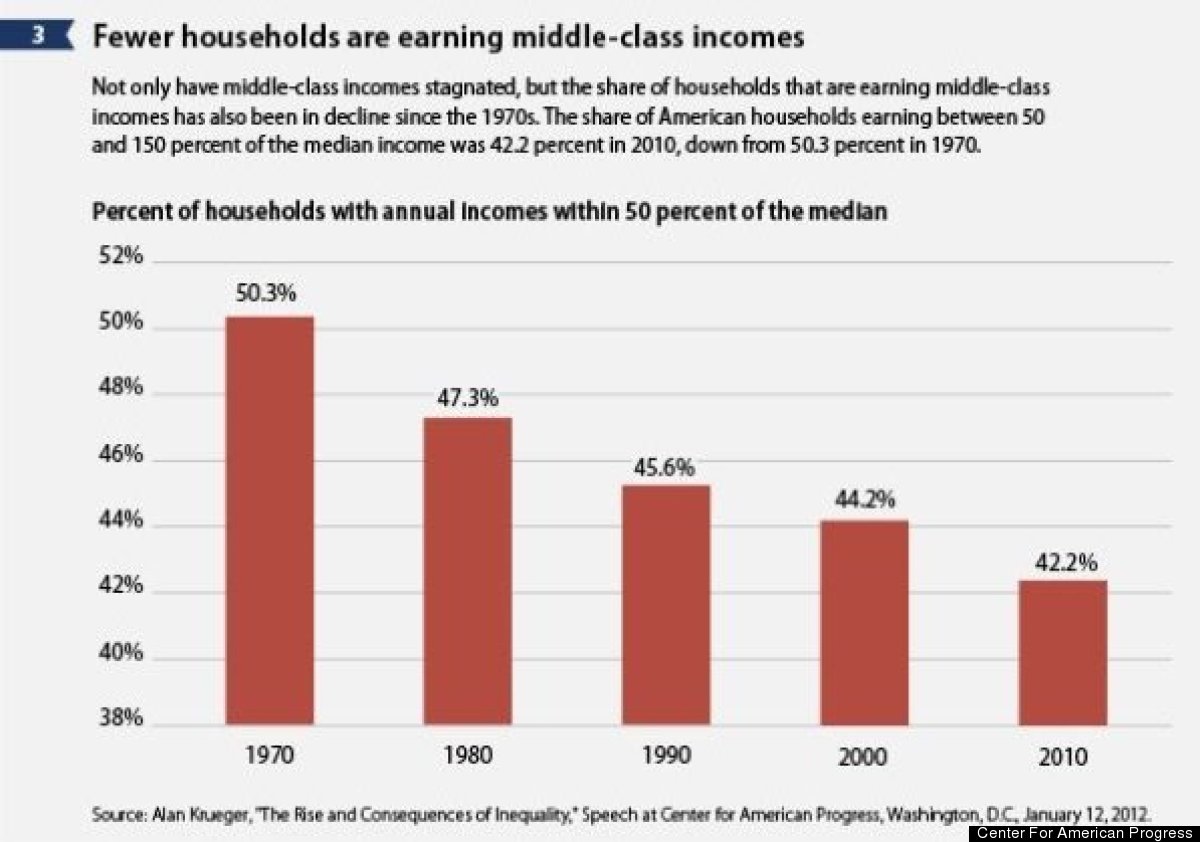

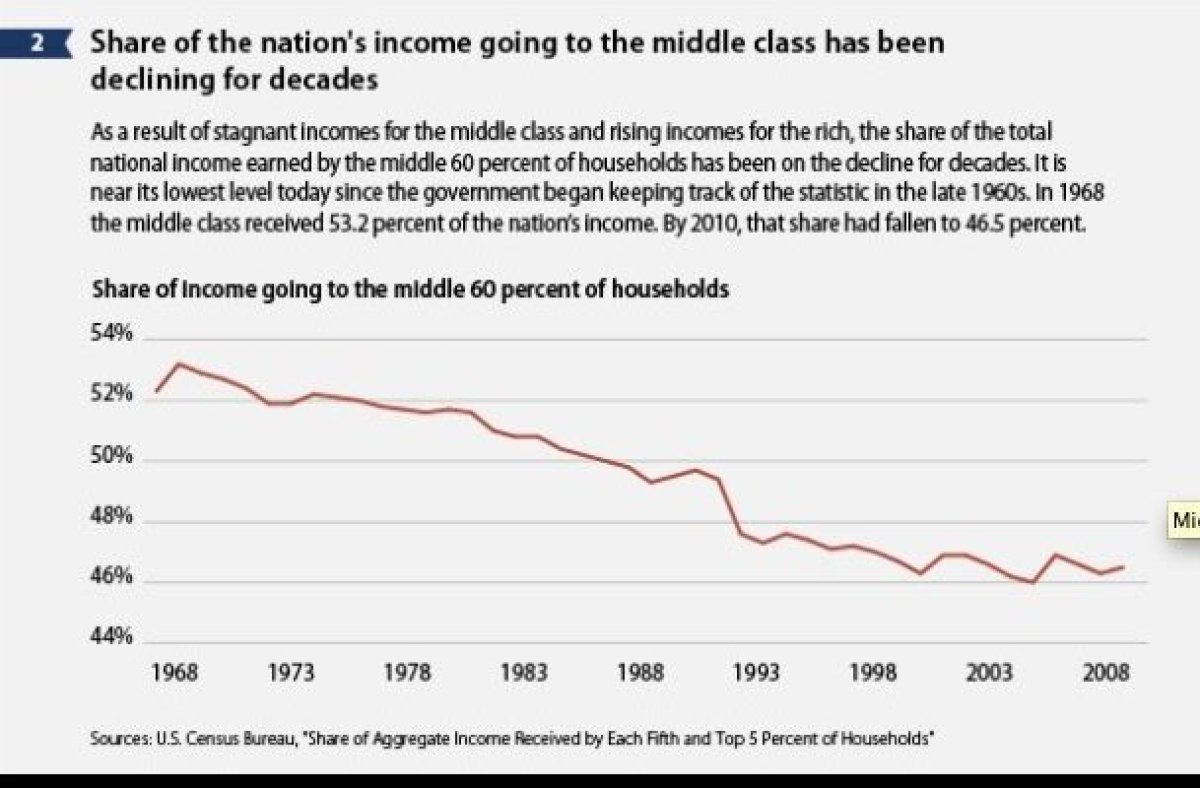
http://www.huffingtonpost.com/2012/09/01/middle-class-america-charts_n_1847211.html#slide=1459758
"A lost decade for the middle class during which its income fell for the first time since World War II, according to a recent report from the Pew Research Center."
Here are 3 of the 5 charts in the article. What do you think?



Economic inequality and natural disasters (and snowstorms)
So class really is everywhere in our lives. I've been thinking about how lucky I was to not have lost heat or hot water, to live in a city that can afford plows (unlike Central Falls and Woonsocket), to have a fridge full of food, and to have the ready cash to pay someone to dig out my car from the piles of packed and hardened snow created by the street plows. But its not luck - except that trees did not fall on electricity lines near my house. The rest of it is a measure of class privilege
Here is an article on economic inequality and natural disasters that caught my interest.
http://thinkprogress.org/economy/2012/10/29/1104111/economic-inequality-hurricanes/?mobile=nc Posted just before Hurricane Sandy Thinkprogress.org is a web site you might investigate
How Economic Inequality Makes Hurricanes More Deadly
By Zack Beauchamp on Oct 29, 2012 at 11:50 am
While the Eastern seaboard braces for Hurricane Sandy, 65 people have already been killed
by the storm in the Caribbean. The tragic death toll and accompanying
widespread property damage are caused in part by poor infrastructure and
poverty — problems that aren’t limited to the Caribbean. Indeed,
America’s inequality problem is a key reason why natural disasters wreak
such havoc inside the United States.
That our stratified society makes storms more deadly is nearly
universally believed by disaster experts. According to a paper by three
experts at the University of South Carolina (Cutter et al.),
“[t]here is a general consensus within the social science community”
that some key causes of vulnerability to storms include “lack of access
to resources (including information, knowledge, and technology); limited
access to political power and representation; social capital, including
social networks and connections; beliefs and customs; building stock
and age; frail and physically limited individuals; and type and density
of infrastructure and lifelines.” Inequality was, the researchers found,
the single most important predictor of vulnerability to storm damage —
variation in the wealth of individual counties alone explained 12.4
percent of the differences in the impact of natural disasters between
counties. The reasons for this are fairly clear — poorer communities have less resources to evacuate and prepare for storms, and also live in housing that’s less likely to be build to withstand nature’s wrath. As Kathleen Tierney at the University of Colorado puts it:
[Dimensions] of social class, including education and income, affect the ability to engage in self-protective activities across all phases of the hazard cycle. Educational achievements and literacy competence influence access to information on disaster risks and risk-reduction measures…The lack of affordable housing in U.S. metropolitan areas forces the poor to live in substandard housing that is often located in physically vulnerable areas and also to live in overcrowded housing conditions. Manufactured housing may be the only viable housing option for people with limited resources, but mobile homes can become death traps during hurricanes and tornadoes…disaster evacuation scenarios are also based on other assumptions, such as the idea that in addition to having their own transportation, households also have the financial resources to leave endangered communities when ordered to do so. This is definitely not true for the poor.Other sorts of related inequalities also make the impact of storms worse. Cutter et al. found that black, Hispanic, and Asian communities in the United States were also more at risk from storms, as were communities dependent on one industry (like mining or fishing), ones with high percentages of residents living in mobile homes, and ones with high population density.
Saturday, January 26, 2013
Powerful myths about class - and a reality check video
I thought it would be helpful to reiterate the myths about class that we talked about last week. These myths or beliefs effect our understanding of class and of our own place in the world. We use them to evaluate ourselves and each other.
*Myth #1
The US is a classless society
*Myth #2
We are a meritocarcy, that is,we evaluate people based on their merit and accomplishments
*Myth#3
Anyone who works hard can achieve the American dream.
*Myth#4
What's good for business is good for the rest of us. [We often see this in reports about the improving stock market. The message there is that if the market is improving, that benefits everyone. But who owns stocks?]
*Myth#5
Inequality is natural and necessary
Here's a fun video on the distribution of class. I had planned to do this in class with ten chairs but we ran out of time.
*Myth #1
The US is a classless society
*Myth #2
We are a meritocarcy, that is,we evaluate people based on their merit and accomplishments
*Myth#3
Anyone who works hard can achieve the American dream.
*Myth#4
What's good for business is good for the rest of us. [We often see this in reports about the improving stock market. The message there is that if the market is improving, that benefits everyone. But who owns stocks?]
*Myth#5
Inequality is natural and necessary
Income, Wealth and Inequality
It is important that we have some basic knowledge about income and wealth over time.
#1 The Color of Wealth
#2 Racial Wealth Gap
The point with this graph is two fold. The income gap between middle and low-income households is huge AND this gap in US society has become greater in the past 20 years.
#1 The Color of Wealth
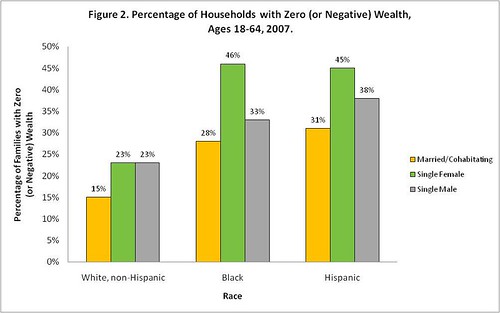 | |||||
| Which racial group has negative wealth? and to what degree? |
#2 Racial Wealth Gap
The point with this graph is two fold. The income gap between middle and low-income households is huge AND this gap in US society has become greater in the past 20 years.
 |
Wednesday, January 23, 2013
Popular images of working class people
First Week, January 23, 2013

I'm not sure what visuals best represent our topic but here are some contrasting ones. The working class people above are striking to improve their lives. They have dignity and courage. Below is another popular image of working class people. But these particular working people, though they were rich, were not portrayed as having dignity or courage. The joke in the show was that working people, even those who became rich, were childlike in their view of the world. They proved unable to adapt to their new situation and this was because they were working people who are not smart at all.

and what does this 'white trash' birthday cake tell us about popular ideas of working class culture and values?


I'm not sure what visuals best represent our topic but here are some contrasting ones. The working class people above are striking to improve their lives. They have dignity and courage. Below is another popular image of working class people. But these particular working people, though they were rich, were not portrayed as having dignity or courage. The joke in the show was that working people, even those who became rich, were childlike in their view of the world. They proved unable to adapt to their new situation and this was because they were working people who are not smart at all.
and what does this 'white trash' birthday cake tell us about popular ideas of working class culture and values?

Subscribe to:
Posts (Atom)

